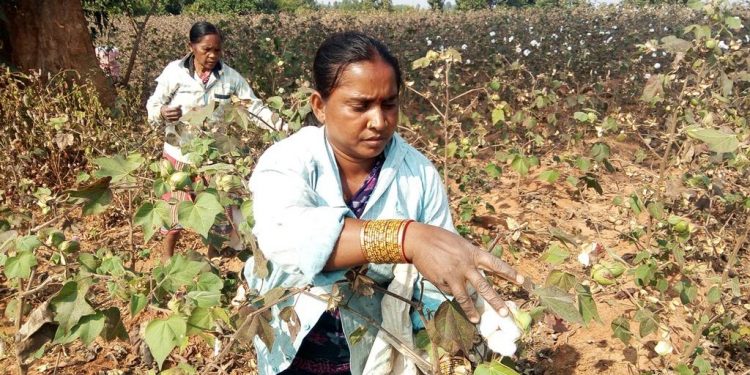Bolangir: Cotton cultivation has seen a rise in the western districts of Bolangir, Kalahandi, Nuapada, Subarnapur, Boudh and Bargarh, and also in Rayagada, Koraput and Gajapati districts in state’s south. However, what ails the farmers is that the middlemen, commission agents, traders and wholesalers take a major chunk of profit from farmers’ produce. Cotton is being grown on 62,433 hectare land in Bolangir district in 2022-23 kharif season.
According to available data, cotton used to be grown only on 5,000 hectare in 1980 which has expanded to over 2 lakh hectare by 2022. The government at the Centre decides the minimum support price (MSP) of cotton as the cotton price is fixed on the basis of the international market. Nevertheless, cotton is sold at a much higher price in the market than the MSP. MSP per quintal of cotton was fixed at Rs 6,025 in 2021 but it was sold at a maximum rate of Rs 12,000 per quintal last year. The bidders from other states got a chance to participate in the trade in Bolangir last year.
As a result, price per quintal of cotton doubled in the district. It was said that cotton farmers earned profit from the cultivation but reality was something else. The actual farmers benefitted more than the previous years but the middlemen gobbled up the lion’s share of the profits. As cotton is a cash crop, the number of middlemen in its cultivation and trade is increasing every year. Interstate bidders, middlemen and local millers are making the most of loopholes in the system and government policies and eating into the margins of farmers.
While farmers earned Rs 7,000 per quintal of cotton, middlemen, who purchased cotton from the farmers, got anything between Rs 10,000 to Rs 12,000. The bidders managed to increase the selling price of cotton but the administration has failed to rein in the middlemen.
A farmer Rajendra Behera of Sihini village under Belpada block admitted that he has earned more per quintal of cotton than the previous year but the middlemen grabbed major chunk of earning. “Government should buy cotton from the farmers through mandis instead of the millers. He alleged that the farmers are being deprived of actual profit due to apathetic attitude of the state government and the loopholes in the cotton purchase policy,” he added. The selling price of cotton went up last year as the government allowed the outside traders to buy cotton directly from the farmers. This benefitted the farmers. This year, the Cotton Corporation of India (CCI) has fixed the minimum price per quintal of cotton at Rs 6,380.
Harvest season has started in Bolangir and other districts from first week of November but the meeting of the district level cotton procurement committee is yet to be conducted. With the start of the harvest season, middlemen are moving from village to village transporting cotton outside. The middlemen and traders have also introduced the system of advance payment like migrant labourers in cotton cultivation. They are paying money in advance to the farmers to buy seeds, fertilizers and pesticides by signing a contract and buying their produce after the harvest. As a result, middlemen are earning more profits than the farmers.
Moreover, the district administrations have not opened any mandi to purchase cotton except through three regulated market committees (RMCs). The CCI is also not intervening as cotton is being sold at prices more than the MSP. Lack of registration facility for cotton farmers has also hit them. It is difficult to differentiate between an actual farmer and a middleman. Meanwhile, cotton is sold at higher prices in international market than the MSP. It is apprehended that this might soon affect the farmers if the government does not take any preventive steps. When contacted, Collector Chanchal Rana said that the administration is making arrangements to help the cotton farmers earn more.






































